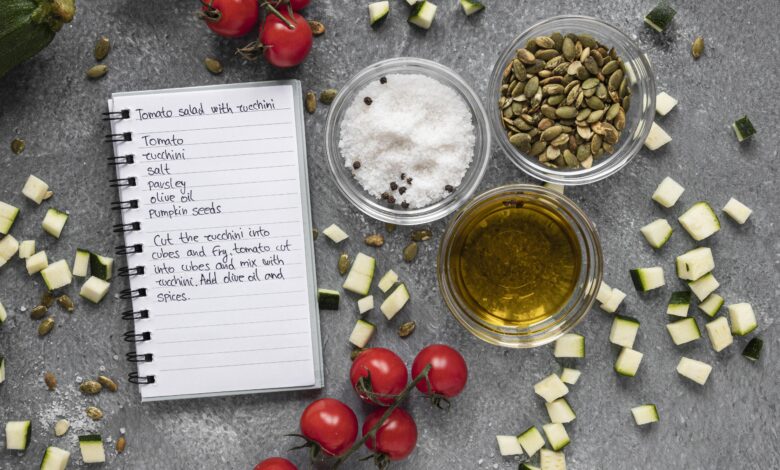Low-Sodium Recipe and Cooking Tips: A Guide to Flavorful, Healthy Meals

Reducing sodium in your diet doesn’t mean sacrificing flavor. A low-sodium lifestyle can be both delicious and beneficial, helping to reduce the risk of hypertension, heart disease, and kidney issues. Here’s a comprehensive guide on low-sodium cooking, complete with practical tips and flavorful recipes.
Understanding Sodium and Its Role in Diet
Sodium is an essential mineral that helps regulate fluid balance and nerve function. However, most people consume far more than the recommended daily amount of 2,300 milligrams (or about one teaspoon of salt). Processed foods, canned goods, and restaurant meals are often the biggest culprits of excessive sodium intake.
Low-Sodium Cooking: The Basics
- Read Labels Carefully
When shopping, look for products labeled “low sodium,” “no salt added,” or “reduced sodium.” Always check the nutrition facts to ensure the sodium content aligns with your dietary goals. - Cook at Home
Homemade meals give you control over the ingredients and allow you to limit or eliminate added salt. - Season Smartly
Use herbs, spices, and other natural seasonings to enhance the taste of your food. Experiment with garlic, ginger, citrus zest, and vinegar for bold flavors. - Avoid Processed Foods
Foods like instant soups, frozen dinners, and salty snacks often contain high sodium levels. Opt for fresh or frozen vegetables, whole grains, and lean proteins instead.
Low-Sodium Ingredients to Stock Up On
- Fresh herbs and spices (e.g., basil, oregano, cumin, paprika)
- Low-sodium or sodium-free broths
- Lemon juice and vinegar
- Fresh or frozen fruits and vegetables
- Unsalted nuts and seeds
- Whole grains like quinoa, brown rice, and oats
Flavorful Low-Sodium Cooking Techniques
- Marinate for Depth
Marinades with ingredients like olive oil, garlic, herbs, and vinegar can impart deep flavors to meats and vegetables. - Roasting for Natural Sweetness
Roasting vegetables enhances their natural sweetness and flavor, eliminating the need for extra salt. - Layering Flavors
Use a variety of spices and herbs to build complexity in your dishes. Add them at different stages of cooking for a nuanced taste. - Searing and Grilling
These cooking methods create a caramelized, smoky flavor that can make food more satisfying without added salt.
Recipe: Low-Sodium Herb and Lemon Grilled Chicken
Ingredients:
- 4 boneless, skinless chicken breasts
- 3 tablespoons olive oil
- 2 tablespoons lemon juice
- 2 teaspoons minced garlic
- 1 teaspoon dried oregano
- 1 teaspoon paprika
- ½ teaspoon black pepper
Instructions:
- In a bowl, mix olive oil, lemon juice, garlic, oregano, paprika, and pepper.
- Place chicken breasts in a resealable bag or shallow dish and pour the marinade over them. Refrigerate for at least 30 minutes or overnight for more flavor.
- Preheat a grill or grill pan to medium-high heat.
- Grill chicken for 6-7 minutes per side or until fully cooked. Serve with a side of roasted vegetables for a complete meal.
Recipe: Roasted Vegetable Medley
Ingredients:
- 1 cup broccoli florets
- 1 cup carrot slices
- 1 cup zucchini slices
- 2 tablespoons olive oil
- 1 teaspoon garlic powder
- 1 teaspoon smoked paprika
- ½ teaspoon black pepper
Instructions:
- Preheat the oven to 400°F (200°C).
- Toss vegetables with olive oil, garlic powder, smoked paprika, and black pepper.
- Spread the vegetables evenly on a baking sheet.
- Roast for 20-25 minutes, stirring halfway through, until tender and slightly caramelized.
Tips for Dining Out on a Low-Sodium Diet
- Request sauces and dressings on the side or skip them altogether.
- Ask the kitchen to prepare your dish without added salt.
- Opt for steamed, grilled, or baked items rather than fried foods.
Benefits of a Low-Sodium Diet
Adopting a low-sodium lifestyle can lead to numerous health benefits, including improved blood pressure levels, reduced risk of stroke, and better kidney function. Additionally, learning to cook with less salt often leads to discovering new flavors and techniques that enhance your culinary skills.
Conclusion
Cooking low-sodium meals doesn’t have to be a challenge. By choosing fresh ingredients, experimenting with herbs and spices, and adopting healthy cooking methods, you can create dishes that are both heart-healthy and satisfying. Whether you’re managing a health condition or simply aiming for a healthier lifestyle, these tips and recipes provide the perfect starting point. Start small, experiment, and enjoy the journey to flavorful, low-sodium living!




